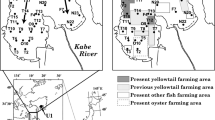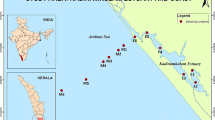Abstract
The aim of this research is to determine the effects of Izmir Big Channel Waste Water Treatment Project on the sediment quality of Izmir Bay. Wastewater treatment improves the water quality. However, sediment does not respond to this treatment as fast as water column. Monitoring of bottom water and sediment quality is necessary for identification of the recovery of the whole ecosystem. For this purpose, bottom water and sediment samples were collected from three stations which are located in the middle and inner parts of the Izmir Bay on a monthly basis between January 2003 and December 2003. Values measured at stations ranged between; 0.54–12.82 µg/L for chlorophyll-a, 0.09–9.32 µg/L for phaeopigment, 0.05–1.91 mg/L for particulate organic carbon in bottom waters, 11.88–100.29 µg/g for chlorophyll degradation products and 1.12–5.39% for organic carbon in sediment samples. In conclusion, it was found that grazing activity explained carbon variations in sediment at station 2, but at station 1 and station 3 carbon variations in sediment were not related to autochthonous biological processes.
Similar content being viewed by others
References
Aksu, A. E., Yatar, D., & Uslu, O. (1998). Assessment of marine pollution in Izmir Bay; heavy metal and organic compound concentrations in surficial sediments. Translations and Journal of Engineering and Environmental Science, 22, 387–415.
Angeldis, M., Grimanis, A. D., Zafiropoulos, D., & Vassilaki- Grimani, M. (1980). Trace elements in sediments of Evoikos Gulf, Greece. Ves Journe’es Etud. Poll.Cagliari, CIESM, 413–418.
Anon (1992). Environmental impact report of alternative dumping areas of Izmir Harbour and approaching channel dredged material, (in Turkish), Dokuz Eylul Universitesi Deniz Bilimleri Enst. s, 14–15.
Anon (1997). Izmir Bay Marine Research 1994–1998 (1997 Report), (in Turkish), D. E. U. Den. Bil.Tek.Enst.Proje No:DBTE-098.
Atılgan, İ. (1997). Comparative investigations of carbon, organic matter (loss on ignition) and some heavy metal (Cu, Zn) levels of sediments of Gulluk and Homa Lagoon, (in Turkish) (Yüksek Lisans Tezi, M.Sc.) E. U. Fen Bilimleri Enst. Su Urunleri Anabilim Dalı, pp. 1–15.
Aydın, A. & Sunlu, U. (2005). Investigation of carbon and organic matter (loss on ignition) concentrations in the sediments of South Aegean Sea, (in Turkish), E.U. Su Urunleri Dergisi cilt;21, Sayı;3–4 pp. 229–234.
Duman, M., Avci, M., Duman, S., Demirkurt, E., & Duzbastilar, M. K. (2004). Surficial sediment distribution and net sediment transport pattern in Izmir Bay, Western Turkey. Continental Shelf Research, 24, 965–981.
Egemen, O., Gokpinar, S., Onen, M., Buyukisik, B., Hossucu, B., Sunlu, U., et al. (1999). Gulluk Lagoon ecosystem (Aegean Sea/Turkiye), (in Turkish). Turkish Journal of Agriculture and Forestry Ek Sayı, 3, 927–947.
Environment for Europeans (2005). Keeping our seas alive. Magazine of the Directorate-General for the environment. No;21, pp.3–4. Brussels.
Eppley, R. W. (1972). Temperature and phytoplankton growth in the sea. Fishery Bulletine, 70(4), 1063–1085.
Gaudette, H. E., Flight, W. R., Toner, L., & Folger, W. (1974). An inexpensive titration method for the determination of organic carbon in recent sediments. Journal of Sedimentory Petrology, 44, 249–253.
Hitchcock, G. L. (1982). A comparative study of the size-dependent organic composition of marine diatoms and dinoflagellates. Journal of plankton research, 4, 363–377.
Kaymakci, A., Sunlu, U., & Egemen, O. (2000). Assessment of nutrient pollution caused by land- based activities in Izmir Bay, Turkiye. Meeting on Interdependency between Agriculture, Urbanization: Conflicts on Sustainable Use of Soil, Water, Tunisia: pp. 41–49.
Lorenzen, C. J. (1971). Chlorophyll-degradation products in sediments of Black Sea. WoodsHole Oceanographic Institution Contribution No; 2828, pp. 426–428.
Parsons, T. R., Matia, Y., & Lalli, C. M. (1984). A manual of chemical and biological methods for seawater analysis p. 173. New York: Pergamon Press.
Scoullos, M., & Dassenakis, M. (1982). Trace metal levels in sea water and sediments of Evoikos Gulf. Greece. IVes Journe’es Etud. Poll. Cannes, CIESM, pp. 425–429.
Smayda, T. J. (1997). Harmful algal blooms: Their ecophysiology and general relevance to phytoplankton blooms in the sea. Limnology and oceanography, 42(5, part 2), 1137–1153.
Strickland, J. D. H., & Parsons, T. R. (1972). A practical handbook of seawater analysis. Fisheries Research Board of Canada. Bull. 167. Ottowa, 310 p.
Sunlu, U., Aydın, A., & Egrihanci (Ozcetin) N. E. (2005). Investigation of carbon and organic matter (loss on ignition) concentrations in the sediments of North Aegean Sea, (in Turkish), E.U. Su Urunleri Dergisi, cilt; 22, Sayı, 3–4, 263–268.
Sunlu, U., Egemen, O., Kaymakci, A., & Tüzen (1999). Investigation of impact of fish rearing at net cages on sediment in Urla Pier, (in Turkish), X. Ulusal Su Urunleri Sempozyumu., 22–24 Eylul l999. Adana.
Sunlu, U., Buyukisik, H. B., Koray, T., Brockel, K., Sunlu, F. S., Sever, T. M. et al. (2007). The effects of Izmir Big Channel waste water treatment project to the lower trophic level of Izmir Bay (Aegean Sea, Turkey). The Scientific and Technical Research Council of Turkey (TUBITAK-CAYDAG) Project No;102Y116 Final Report. 253p. (in Turkish).
Turkman, A. (1981). Evaluation of results of the analyses of the secondary rivers discharging to Izmir Bay, (in Turkish), Su ve Toprak Kaynaklari Gelistirme Konferansi, 2, 723–750.
Varnavas, S. P., & Ferentionos, G. (1982). Heavy Metal distribution in the surface sediments of Pataraikos Bay, Greece, Vies Journes’es Etud. Poll.Cannes, CIESM., pp. 405–409.
Yaramaz, O., Modogan, H., Onen, M., Sunlu, U., & Alpbaz, A. (1991). Investigation of some heavy metals (Fe,Mn, Ni) and organic matter (%C) concentrations in the sediments of the Izmir Bay, (in Turkish), Egitiminin 10. Yılında Su Urunleri Sempozyumu.12–14 Kasim 1991, Izmir, s: 406–413.
Yaramaz, Ö., Önen, M., Sunlu, U., & Alpbaz., A. (1992). Comparative investigations of some heavy metal (Pb,Cd,Zn,Cu) levels in the sediments of Izmir Bay, (in Turkish), I. Uluslararası Cevre Koruma Sempozyumu Bildileri. Cevre Kirliligi ve Kontrolu, 2. Cilt. In Zafer AYVAZ (ed.), s.15–19, Ege Universitesi Izmir-TURKIYE.
Author information
Authors and Affiliations
Corresponding author
Rights and permissions
About this article
Cite this article
Sunlu, U., Aksu, M., Buyukisik, B. et al. Spatio-temporal variations of organic carbon and chlorophyll degradation products in the surficial sediments of Izmir Bay (Aegean Sea/Turkey). Environ Monit Assess 146, 423–432 (2008). https://doi.org/10.1007/s10661-007-0088-2
Received:
Accepted:
Published:
Issue Date:
DOI: https://doi.org/10.1007/s10661-007-0088-2




